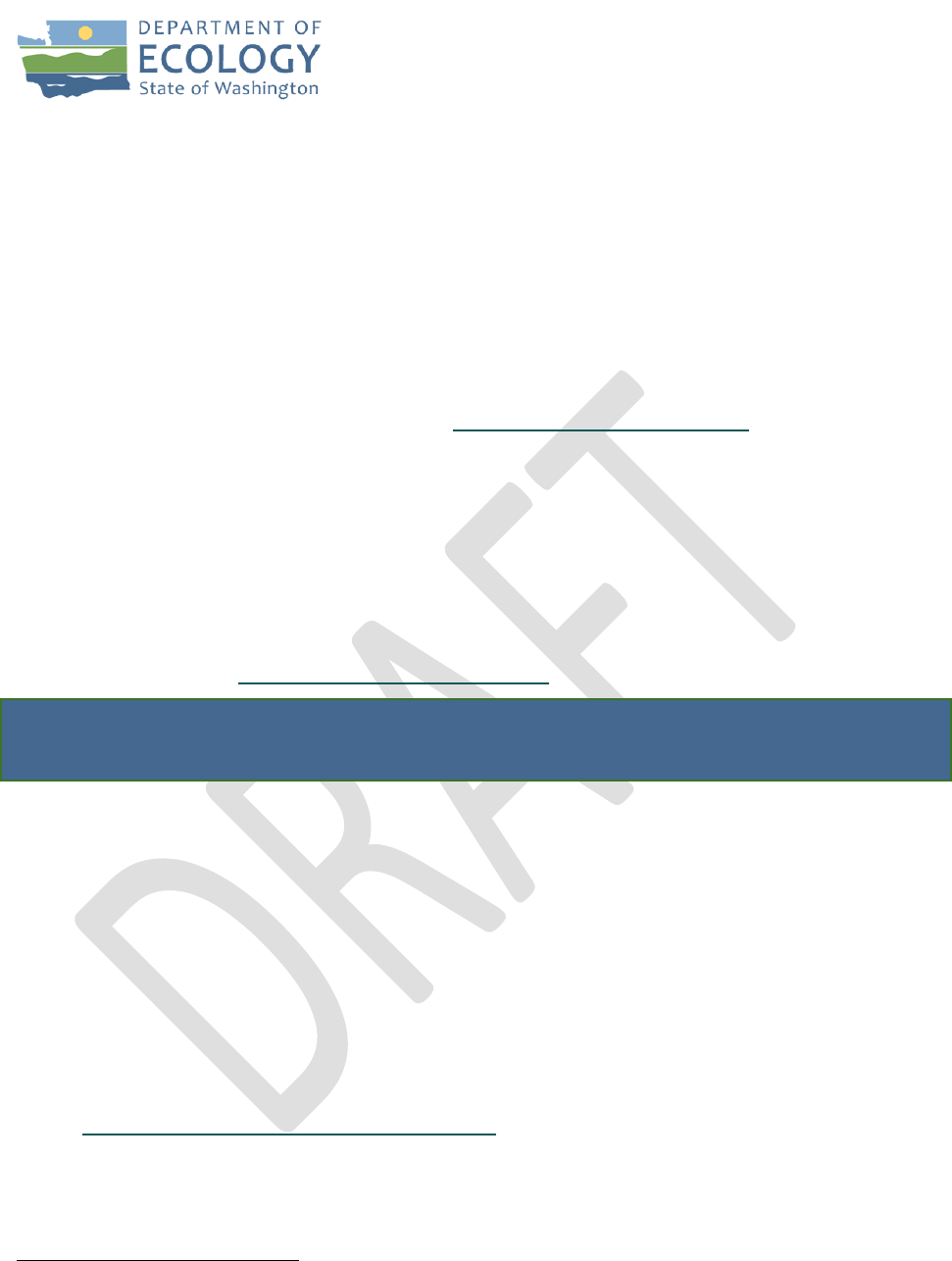
Preliminary Draft Rule Language
Safer Products for Washington
August 2022
Chapter 173-337 WAC
Safer Products Restrictions and Reporting
INTRODUCTION
This document outlines Preliminary Draft Rule Language for a potential new chapter (Chapter
173-337 Washington Administrative Code [WAC], Safer Products Restrictions and Reporting).
This draft rule language includes restrictions and reporting requirements for the Safer Products
for Washington program’s first implementation cycle. If you have questions about this
preliminary draft rule language, contact us at SaferProductsWA@ecy.wa.gov.
How to use this document
Make your voice heard and tell us what you think about the preliminary draft rule. What did we
get right? What should we change?
Questions we have for you
In the preliminary draft, we included questions for reviewers, but we encourage you to provide
feedback on any element of the draft rule. Make note of your input and bring it to a discussion
August 16 or 18, 2022. Send us your feedback in writing
1
if you can’t join either discussion.
Look for sections with a dark blue background and white text to find the questions our team
has on the draft rule.
Tips for providing feedback during the August 16 or 18 discussions
• Tell us what you support and what you disagree with.
• Suggest specific language. This helps our team understand what change you want.
• Use examples to illustrate concerns and explain your feedback.
• Provide supplemental information. Include references supporting your concerns, (such as
regulations, sales data, market information, or brand and product information).
• Offer solutions. Suggest ways we can address your concerns.
We’ll use your feedback to improve our approach and write the formal draft rule. In December
2022, we’ll share the formal draft rule for another round of input.
In the Preliminary Draft Rule Language Overview,
2
we developed two tables you can refer to
while reading the preliminary draft rule. One table includes specific elements of the draft rule
like effective dates and details about limits. The second table includes resources we used to shape
the draft rule requirements.
1
SaferProductsWA@ecy.wa.gov
2
https://www.ezview.wa.gov/Portals/_1962/Documents/saferproducts/PreliminaryDraftRuleLanguage_Overview_
August2022.pdf
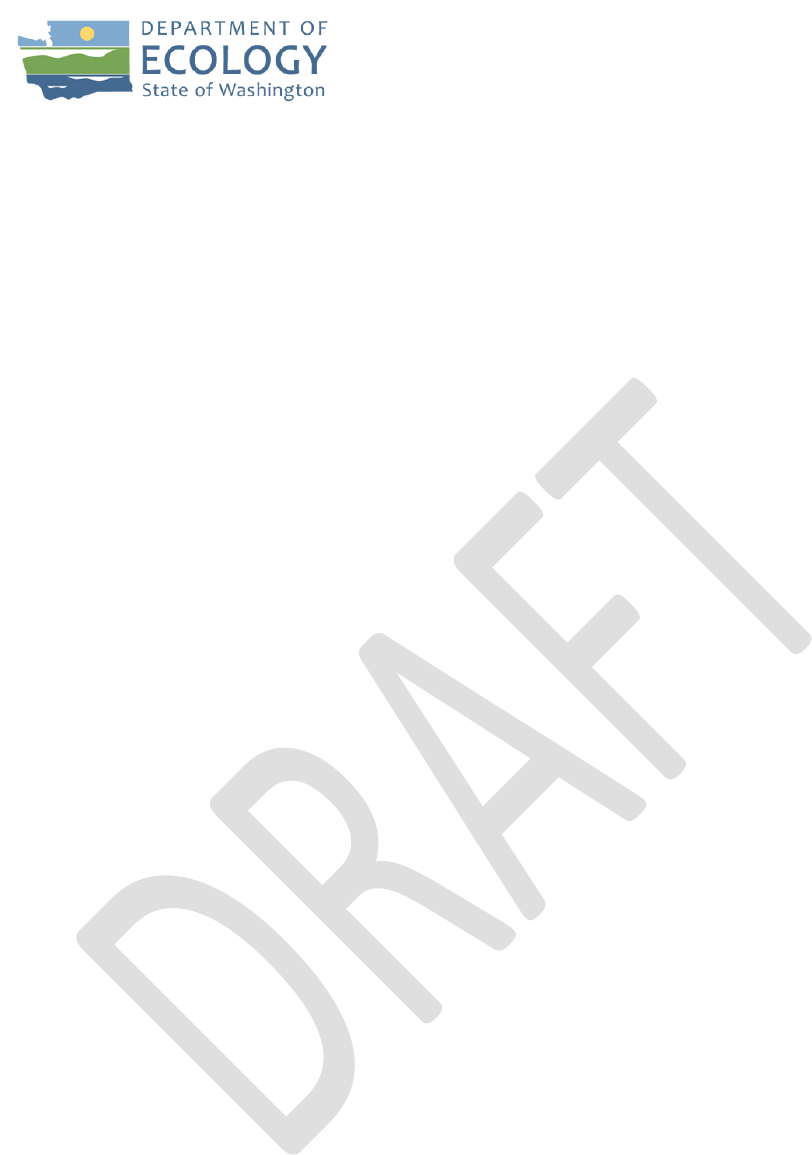
Preliminary Draft Rule Language
Safer Products for Washington
August 2022
OUTLINE: PART A – GENERAL
010 Authority and purpose
015 Applicability
020 Requesting an exemption
025 Acronyms and definitions
030 Enforcement and penalties
035 Appeals
040 Severability
045 Federal preemption
050 Relation to other laws and rules
055 Environmental justice
060 Previously-owned priority consumer products
065 Reporting requirements
OUTLINE: PART B – CHEMICALS AND CONSUMER PRODUCTS
110 PFAS
(1) Aftermarket stain- and water-resistance treatments
(2) Carpets and rugs
(3) Leather and textile furniture and furnishings intended for indoor use
(4) Leather and textile furniture and furnishings intended for outdoor use
111 Ortho-phthalates
(1) Fragrances in beauty products and personal care products
(2) Vinyl flooring
112 Flame retardants
(1) Plastic external enclosures of electric and electronic products intended for indoor
use
(2) Plastic external enclosures of electric and electronic products intended for outdoor
use
(3) Recreational covered wall padding made from polyurethane foam
(4) Other recreational products made from polyurethane foam
113 Alkylphenol ethoxylates
(1) Laundry detergent
114 Bisphenols
(1) Drink can linings
(2) Food can linings
(3) Thermal paper

Preliminary Draft Rule Language
Safer Products for Washington
August 2022
PART A – GENERAL
010 Authority and purpose
(1) Authority. Chapter 70A.350 Revised Code of Washington (RCW) authorizes Ecology to:
(a) Implement, administer, and enforce Chapter 70A.350 RCW.
(b) Regulate priority chemicals in priority consumer products.
(2) Purpose. This chapter implements Chapter 70A.350 RCW.
(a) This chapter provides a regulatory framework to:
(i) Reduce the use of priority chemicals in consumer products by establishing
restrictions.
(ii) Increase transparency in product ingredients by requiring notification.
(b) This chapter establishes:
(i) Actions applicable persons must take to comply with the intent of Chapter
70A.350 RCW.
(ii) Actions applicable persons must take related to manufacturing, selling
(including but not limited to wholesale, online, or retail), or distributing priority
consumer products containing priority chemicals in Washington state.
(iii) The enforcement process Ecology will use if manufacturers fail to comply with
this chapter.
015 Applicability
(1) This chapter applies to persons who:
(a) Manufacture, sell (including but not limited to wholesale, online, or retail), or
distribute priority consumer products containing priority chemicals in Washington
state.
(b) Intentionally add priority chemicals in the production of priority consumer products
in Washington state.
(c) Use a priority consumer product that contains a priority chemical in Washington
state.
(2) This chapter does not apply to:
(a) Consumer products excluded from Chapter 70A.350 RCW.
(b) Consumer products purchased outside of Washington state.
(c) Consumer products transported or stored in Washington state as part of interstate
commerce.

Preliminary Draft Rule Language
Safer Products for Washington
August 2022
(d) Consumer product replacement components manufactured before the effective
date of the restriction.
(e) The recycling or disposal of existing stock.
020 Requesting an exemption
(1) A person required to comply with this chapter may request an exemption from the
requirements of this chapter.
(2) A person seeking exemption from the requirements of this chapter must submit a request
to Ecology that includes the following information.
(a) Your name and address.
(b) Requirements in this chapter from which you request an exemption.
(c) A statement of the need and justification for the exemption. Include information,
data, and sources relevant to the need and justification.
025 Acronyms and definitions
Unless Ecology determines the context requires otherwise, the following definitions apply for
the purposes of this chapter.
Bisphenol means a chemical with two phenol rings connected by a single linker atom. The linker
atom and phenol rings may have additional substituents.
Chemical Abstracts Service number or CAS means the number assigned for identification of a
particular chemical by the Chemical Abstracts Service, a service of the American Chemical
Society that indexes and compiles abstracts of worldwide chemical literature called Chemical
Abstracts.
Consumer product means any item, including any component parts and packaging, sold for
residential or commercial use.
Ecology means the Washington State Department of Ecology.
Electronic product includes personal computers, audio and video equipment, calculators,
wireless phones, game consoles, and handheld devices incorporating a video screen that are
used to access interactive software, and the peripherals associated with such products.
Existing stock means consumer products in commerce at the time a restriction takes effect.
External enclosures means external plastic enclosures of casings of finished electronic products
sold in their functional form. Enclosures are also called device casing. Other components of the
product including printed circuit boards, internal fans, wires, cords, cables, switches, light bulbs,
connectors, and screens are not part of the external enclosure.
FDA means the United States Federal Drug Administration.
Intended for indoor use means a product designed primarily for use inside buildings.

Preliminary Draft Rule Language
Safer Products for Washington
August 2022
Intended for outdoor use means a product designed to maintain functionality after exposure to
ultraviolet (UV) light, water, or immersion when used outdoors for an extended time.
Intentionally added chemical means a chemical in a product that serves an intended function
in the product component.
Inaccessible electronic component means a part or component of an electronic product that is
located inside and entirely enclosed within another material and is not capable of coming out of
the product or being accessed during any reasonably foreseeable use or abuse of the product.
Manufacturer means any person, firm, association, partnership, corporation, governmental
entity, organization, or joint venture that produces a product or is an importer or domestic
distributor of a product sold or offered for sale in or into the state.
Organohalogen means a class of chemicals that includes any chemical containing one or more
halogen elements bonded to a carbon.
Ortho-phthalates means synthetic chemical esters of phthalic acid.
Perfluoroalkyl and polyfluoroalkyl substances or PFAS chemicals means a class of fluorinated
organic chemicals containing at least one fully fluorinated carbon atom.
Phenolic compounds means alkylphenol ethoxylates and bisphenols.
Phthalic acid means a benzenedicarboxylic acid consisting of two carboxy groups at ortho
positions.
ppm means parts per million.
Priority chemical means a chemical or chemical class used as, used in, or put in a consumer
product including:
• Perfluoroalkyl and polyfluoroalkyl substances.
• Phthalates.
• Organohalogen flame retardants.
• Flame retardants, as identified by the Washington State Department of Ecology under
Chapter 70A.430 RCW.
• Phenolic compounds.
• Polychlorinated biphenyls.
• A chemical identified by Ecology as a priority chemical under RCW 70A.350.020.
Priority consumer product means a product identified by Ecology to be a significant source or
use of a priority chemical.
Product component means a uniquely identifiable material or coating (including ink or dye)
that is intended to be included as a part of a finished product.
RCW means Revised Code of Washington.
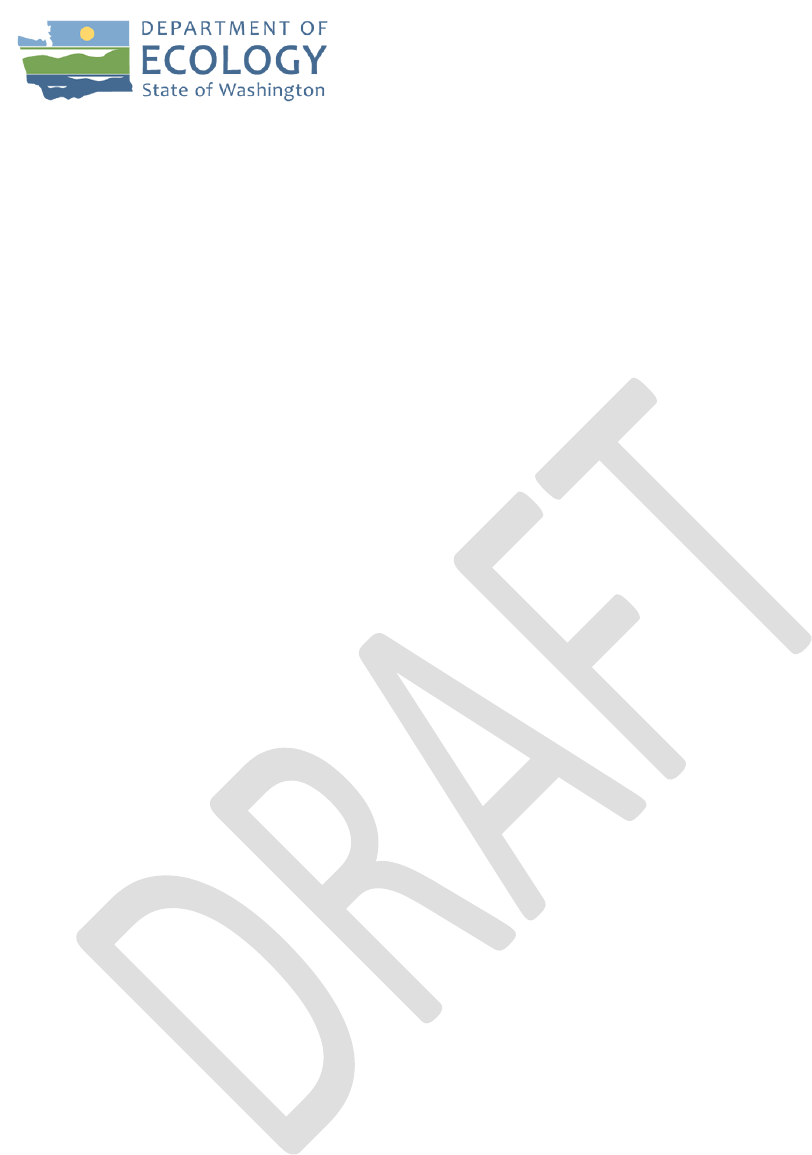
Preliminary Draft Rule Language
Safer Products for Washington
August 2022
TMBPF means tetramethyl bisphenol F (CAS RN: 5384-21-4).
U.S.C. means the United States Code.
WAC means Washington Administrative Code.
030 Enforcement and penalties
(1) Any violation of this chapter is subject to the enforcement and penalty sanctions of
Chapter 70A.350 RCW.
(2) In accordance with Chapter 70A.350 RCW:
(a) A manufacturer violating a requirement of this chapter is subject to a civil penalty
not to exceed five thousand dollars for each violation in the case of a first offense.
Manufacturers who are repeat violators are subject to a civil penalty not to exceed
ten thousand dollars for each repeat offense.
(b) A manufacturer may appeal any penalty provided for in this chapter to the pollution
control hearings board.
(c) All penalties collected under this chapter shall be deposited in the model toxics
control operating account created in RCW 70A.305.180.
035 Appeals
Any persons adversely affected by an Ecology decision under this chapter may appeal the
decision to the Pollution Control Hearings Board pursuant to Chapter 43.21B RCW.
040 Severability
If any provision of this chapter or its application to any person is held invalid, the remainder of
this chapter or the application of the provision to other persons or circumstances is not
affected.
045 Federal preemption
In the event that the requirements of the Toxic Substances Control Act, 15 U.S.C. §§2601, et
seq., or other applicable federal regulations or actions preempt a restriction in this chapter,
that restriction changes to a reporting requirement.
050 Relation to other laws and rules
In addition to the requirements of this chapter and Chapter 70A.350 RCW, other laws, rules,
and ordinances may apply to priority consumer products containing priority chemicals. Nothing
in this chapter prevents persons regulated by this chapter from complying with other laws,
rules, ordinances, procedures, other restrictions, or limitations on regulated consumer
products.
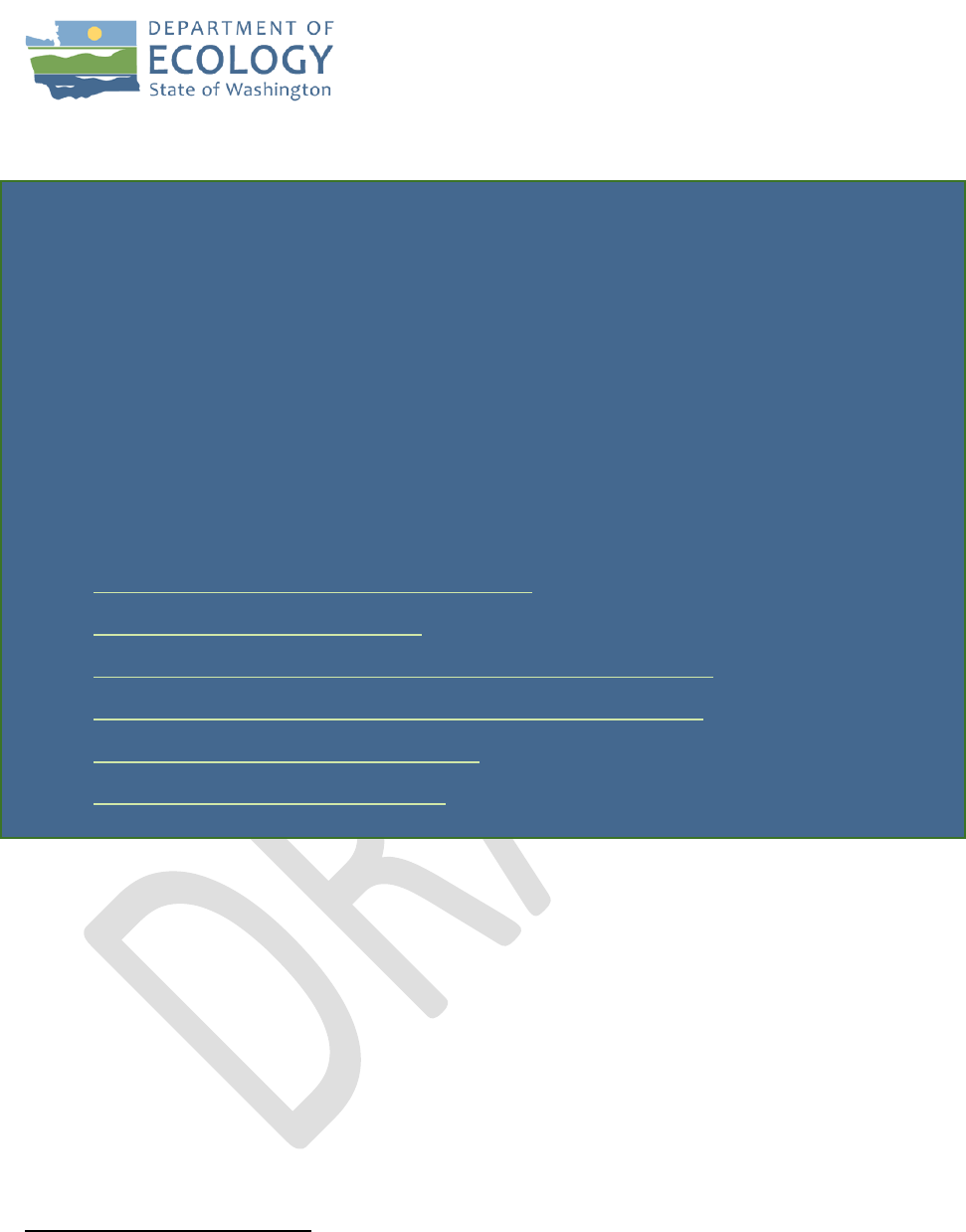
Preliminary Draft Rule Language
Safer Products for Washington
August 2022
055 Environmental justice
QUESTIONS
Ecology plans to include language about addressing environmental justice when implementing,
administering, and enforcing Chapter 70A.350 RCW.
• What ideas do you have for addressing environmental justice when implementing,
administering, and enforcing Chapter 70A.350 RCW?
• How should the rule incorporate environmental justice?
• What language should Ecology use in the rule?
• Providing your ideas, revised language, references to example regulations or industry
practices, and justification will help Ecology make informed changes.
RESOURCES
• Chapter 70A.02 RCW – Environmental Justice
3
• Washington State Office of Equity
4
• Washington State Department of Ecology Environmental Justice
5
• Washington State Department of Health Environmental Justice
6
• The White House Environmental Justice
7
• The White House Justice40 Initiative
8
060 Previously-owned priority consumer products
No person may knowingly sell (including but not limited to wholesale, online, or retail) or
distribute a previously-owned restricted priority consumer product that contains a priority
chemical.
065 Reporting requirements
(1) Applicability
(a) This section applies to persons required to submit notification. This chapter refers to
that person as the “reporting party.”
3
https://app.leg.wa.gov/RCW/default.aspx?cite=70A.02&full=true#70A.02.100
4
https://equity.wa.gov/
5
https://ecology.wa.gov/About-us/Who-we-are/Environmental-Justice
6
https://doh.wa.gov/community-and-environment/health-equity/environmental-justice
7
https://www.whitehouse.gov/environmentaljustice/
8
https://www.whitehouse.gov/environmentaljustice/justice40/
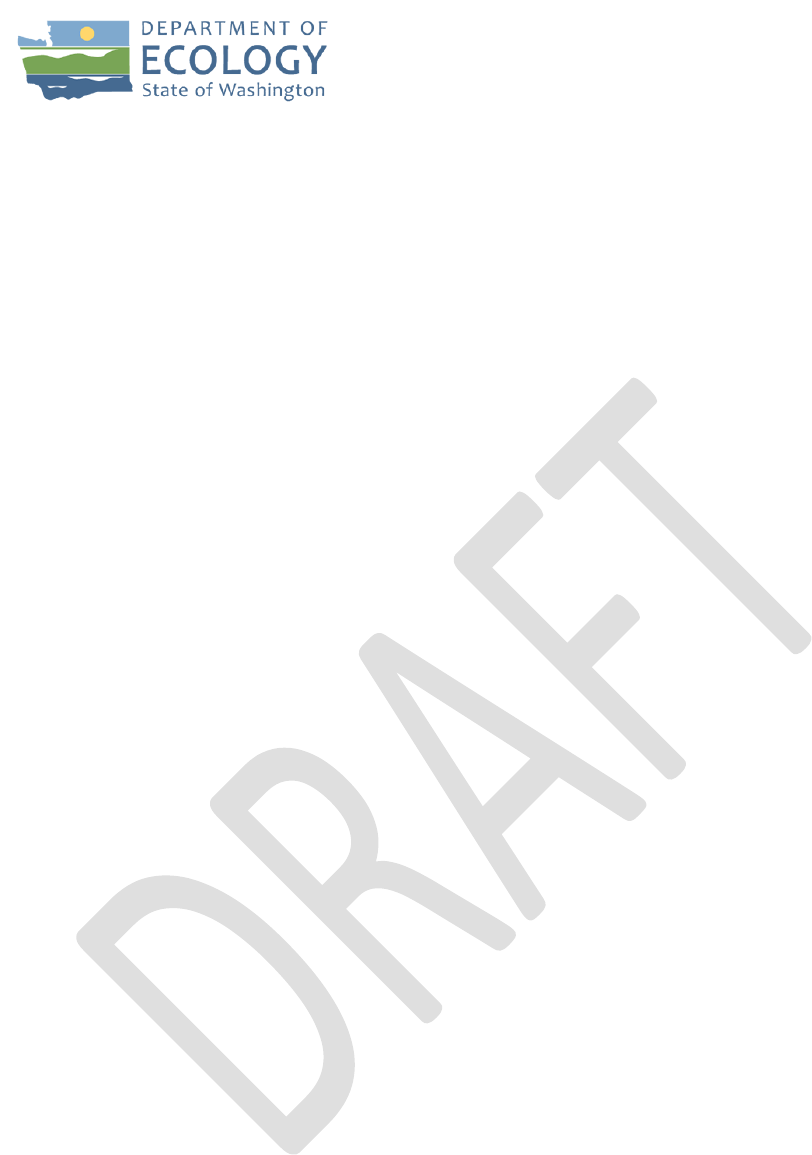
Preliminary Draft Rule Language
Safer Products for Washington
August 2022
(b) The manufacturer of the priority consumer product or a trade organization
representing the manufacturer may serve as the reporting party.
(c) This chapter requires only one reporting party to submit notification with respect to
a priority consumer product containing a priority chemical. Use the following
hierarchy to determine which persons should serve as the reporting party.
(i) The person or entity that had the priority consumer product manufactured.
(ii) The person or entity that marketed the priority consumer product under their
name or trademark.
(iii) The first person or entity, whether an importer or a distributor, who owned
the priority consumer product in the United States.
(2) Timing
(a) The reporting party must notify Ecology by January 31, 2024 and annually thereafter
by January 31 each year.
(b) The reporting party may submit a revised notification to Ecology when a priority
consumer product no longer contains a priority chemical.
(3) Notification contents. The notification must include information about a priority
consumer product sold or offered for sale in Washington state during the prior calendar
year. The notification must include the following information.
(a) The name and CAS of any chemicals included in the priority chemical class.
(b) The priority consumer product.
(c) The product component that contains the priority chemical.
(d) A description of the function of the priority chemical.
(e) The total concentration of the priority chemical in each product component in the
priority consumer product.
(f) Contact information
(i) The name and address of the reporting party.
(ii) The name, address, phone number, and electronic mail address of the contact
person for the reporting party.
(iii) When a trade organization serves as the reporting party, the notification must
include a list of the manufacturers they report for and all the required
information.
(g) Any other information the reporting party deems relevant to the appropriate use of
the product.

Preliminary Draft Rule Language
Safer Products for Washington
August 2022
(4) If the reporting party determines the information in the prior annual notification did not
change in the current reporting year, they must copy the data from the prior year’s
notification and resubmit that data in the online notification database.
(5) This chapter does not require the reporting party to include:
(a) Specific formulations.
(b) The specific name and address of the facility responsible for the use or addition of a
priority chemical in the priority consumer product or product component.
(6) Confidential business information (CBI). If the reporting party believes the information
they provide is CBI, they may request Ecology treat the information as CBI as provided in
RCW 43.21A.160. Ecology will use their established procedures to determine how to
handle the information.
(7) Notification database
The reporting party must use an Ecology-designated notification database to submit the
required notification to Ecology.
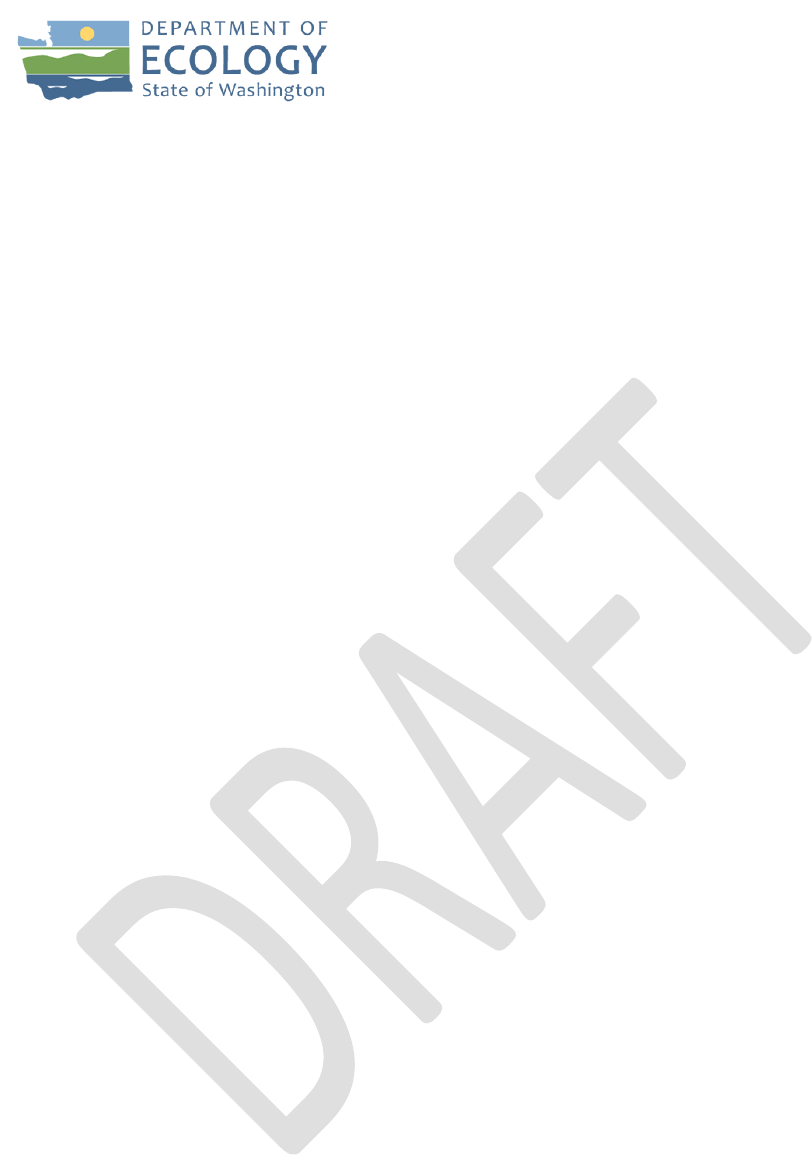
Preliminary Draft Rule Language
Safer Products for Washington
August 2022
PART B – CHEMICALS AND CONSUMER PRODUCTS
110 PFAS
(1) Aftermarket stain- and water-resistance treatments
(a) Applicability
(i) This subsection applies to the following consumer products.
(A) Aftermarket stain-resistant treatments applied to textile and leather
consumer products
(B) Aftermarket water-resistant treatments applied to textile and leather
consumer products
(C) Aftermarket stain-resistant and water-resistant treatments applied to
textile and leather consumer products
(ii) This subsection does not apply to premarket topical chemical treatments
applied during the manufacturing process.
(b) Compliance schedule. The restriction in (c) of this subsection takes effect on January
1, 2025.
(c) Restriction
(i) No person may manufacture, sell (including but not limited to wholesale,
online, or retail), or distribute a consumer product described in (a) of this
subsection that contains intentionally added PFAS.
This does not apply to a consumer product described in (a) of this subsection
manufactured before January 1, 2025.
(ii) Ecology presumes the detection of total fluorine indicates the intentional
addition of PFAS.
(iii) Manufacturers may rebut this presumption by submitting a statement to
Ecology that includes the following information.
(A) The name and address of the person submitting the statement.
(B) A statement that the PFAS were not intentionally added and evidence
supporting that statement. Include information, data, and sources
relevant to demonstrate that the total fluorine is from a source other
than intentionally added PFAS.
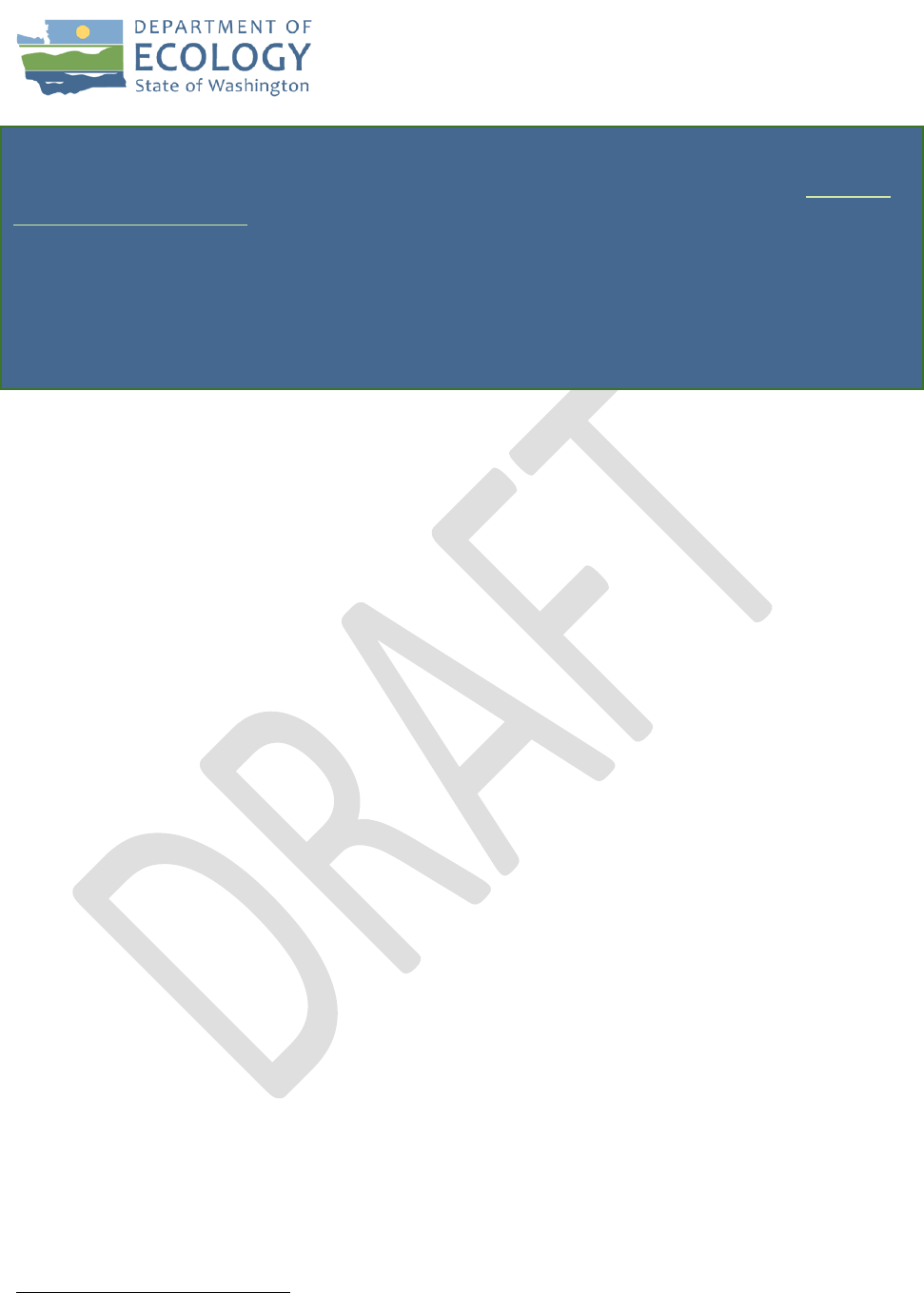
Preliminary Draft Rule Language
Safer Products for Washington
August 2022
QUESTIONS
Ecology changed “cannot contain PFAS” to “intentionally added PFAS” in response to feedback
during the June webinars.
9
Attendees voiced concerns about low-level contamination.
• Do you think this change addressed concerns about low-level contamination?
• Do you think this change causes other concerns? If yes, what are they?
• Providing your ideas, revised language, references to example regulations or industry
practices, and justification will help Ecology make informed changes.
(2) Carpets and rugs
(a) Applicability. This subsection applies to the following consumer products.
(i) Carpets intended for indoor use or intended for outdoor use
(ii) Rugs intended for indoor use or intended for outdoor use, including carpeted
mats
(b) Compliance schedule. The restriction in (c) of this subsection takes effect on January
1, 2025.
(c) Restriction
(i) No person may manufacture, sell (including but not limited to wholesale,
online, or retail), or distribute a consumer product described in (a) of this
subsection that contains intentionally added PFAS.
This does not apply to a consumer product described in (a) of this subsection
manufactured before January 1, 2025.
(ii) Ecology presumes the detection of total fluorine indicates the intentional
addition of PFAS.
(iii) Manufacturers may rebut this presumption by submitting a statement to
Ecology that includes the following information.
(A) The name and address of the person submitting the statement.
(B) A statement that the PFAS were not intentionally added and evidence
supporting that statement. Include information, data, and sources
relevant to demonstrate that the total fluorine is from a source other
than intentionally added PFAS.
9
https://www.ezview.wa.gov/Portals/_1962/Documents/saferproducts/June_2022_Webinar_Presentation.pdf
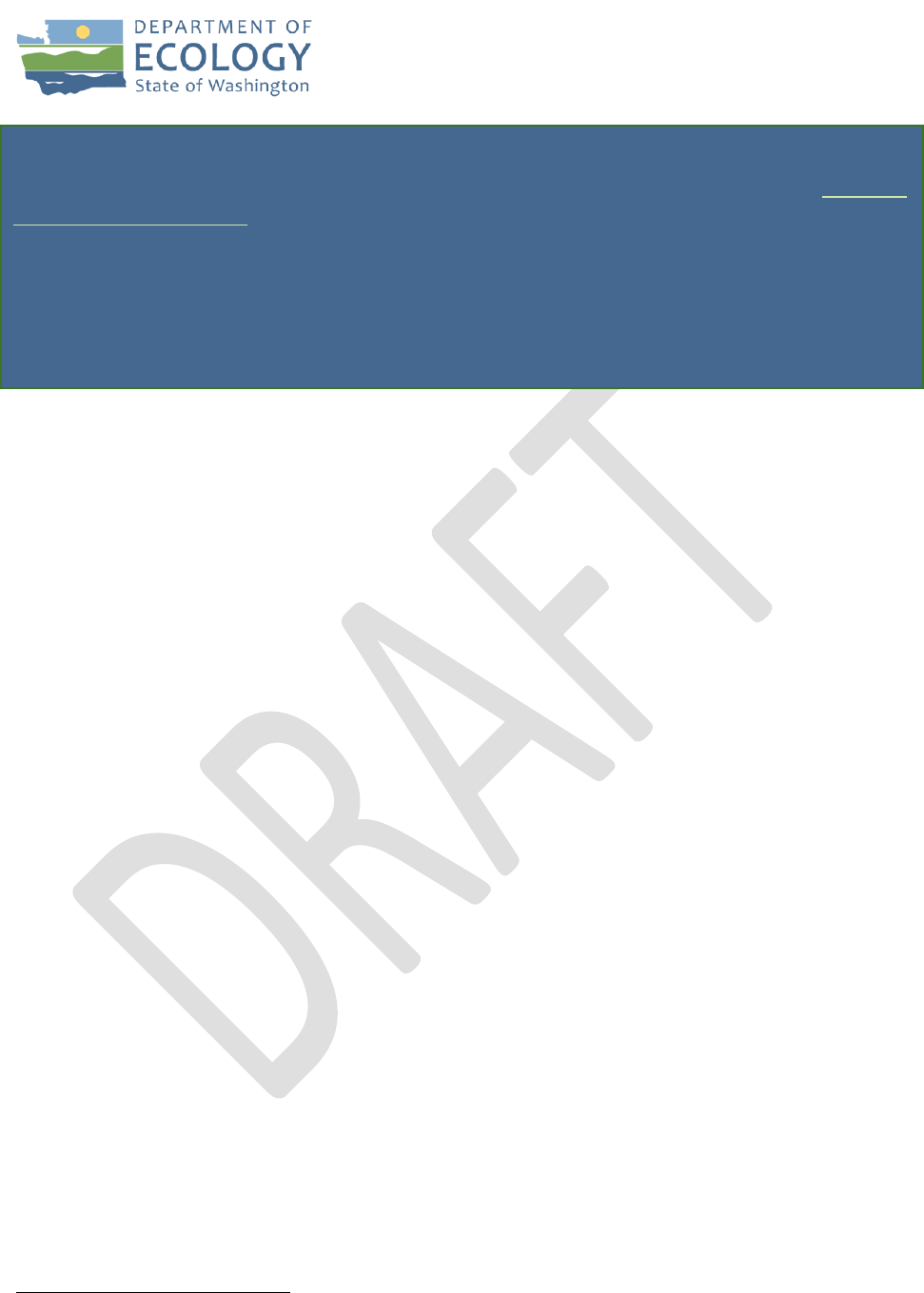
Preliminary Draft Rule Language
Safer Products for Washington
August 2022
QUESTIONS
Ecology changed “cannot contain PFAS” to “intentionally added PFAS” in response to feedback
during the June webinars.
10
Attendees voiced concerns about low-level contamination.
• Do you think this change addressed concerns about low-level contamination?
• Do you think this change causes other concerns? If yes, what are they?
• Providing your ideas, revised language, references to example regulations or industry
practices, and justification will help Ecology make informed changes.
(3) Leather and textile furniture and furnishings intended for indoor use
(a) Applicability
(i) This subsection applies to the following consumer products.
Leather and textile furniture and furnishings intended for indoor use
(ii) This subsection does not apply to leather and textile furniture and furnishings
intended for outdoor use.
(b) Compliance schedule. The restriction in (c) of this subsection takes effect on January
1, 2026.
(c) Restriction
(i) No person may manufacture, sell (including but not limited to wholesale,
online, or retail), or distribute a consumer product described in (a) of this
subsection that contains intentionally added PFAS.
This does not apply to a consumer product described in (a) of this subsection
manufactured before January 1, 2026.
(ii) Ecology presumes the detection of total fluorine indicates the intentional
addition of PFAS.
(iii) Manufacturers may rebut this presumption by submitting a statement to
Ecology that includes the following information.
(A) The name and address of the person submitting the statement.
(B) A statement that the PFAS were not intentionally added and evidence
supporting that statement. Include information, data, and sources
relevant to demonstrate that the total fluorine is from a source other
than intentionally added PFAS.
10
https://www.ezview.wa.gov/Portals/_1962/Documents/saferproducts/June_2022_Webinar_Presentation.pdf
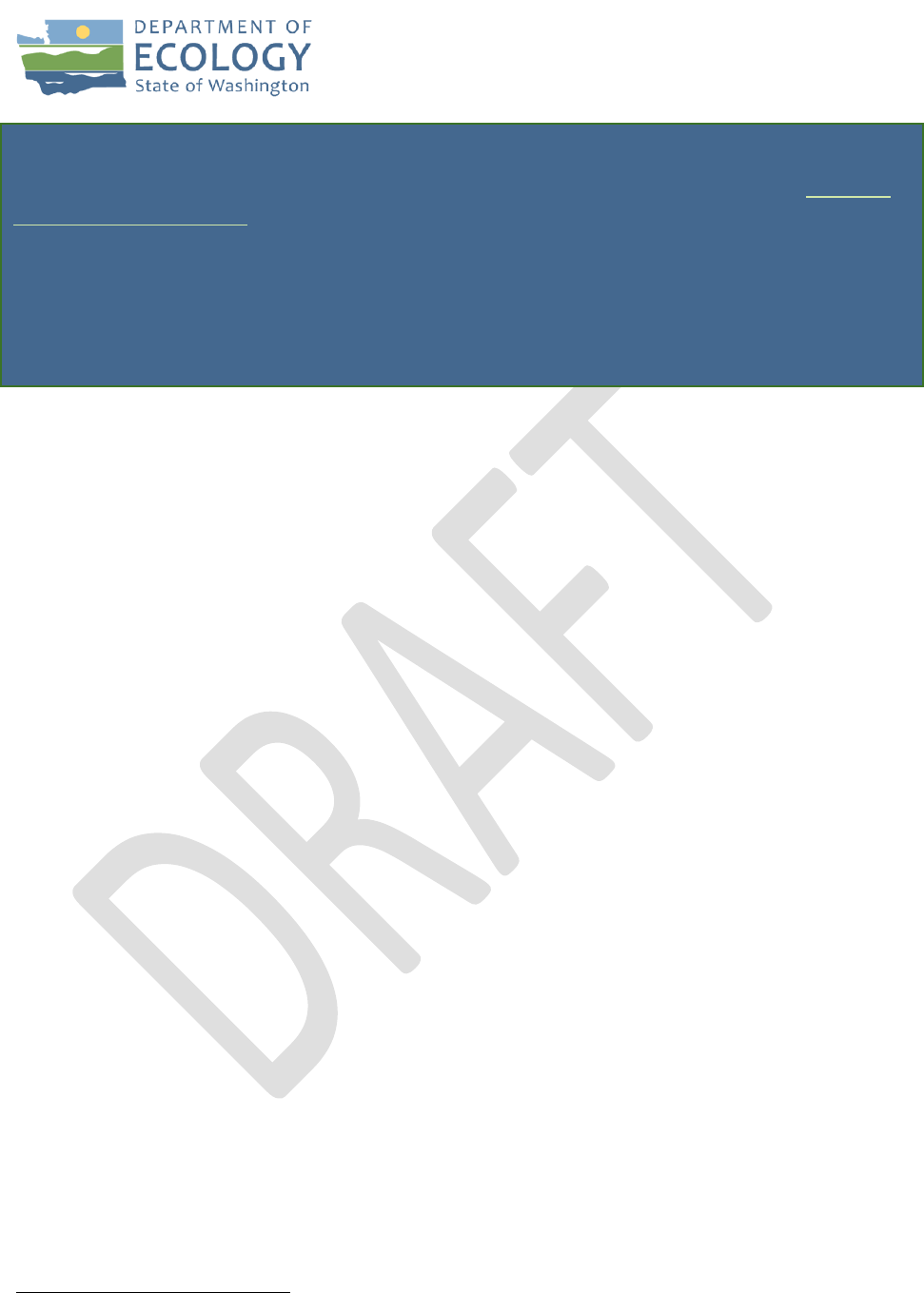
Preliminary Draft Rule Language
Safer Products for Washington
August 2022
QUESTIONS
Ecology changed “cannot contain PFAS” to “intentionally added PFAS” in response to feedback
during the June webinars.
11
Attendees voiced concerns about low-level contamination.
• Do you think this change addressed concerns about low-level contamination?
• Do you think this change causes other concerns? If yes, what are they?
• Providing your ideas, revised language, references to example regulations or industry
practices, and justification will help Ecology make informed changes.
(4) Leather and textile furniture and furnishings intended for outdoor use
(a) Applicability
(i) This subsection applies to the following consumer products.
Leather and textile furniture and furnishings intended for outdoor use
(ii) This subsection does not apply to leather and textile furniture and furnishings
intended for indoor use.
(b) Compliance schedule. The reporting requirement in (c) of this subsection takes effect on
January 1, 2024.
(c) Reporting. The manufacturer must provide notice of the use of PFAS in a consumer
product described in (a) of this subsection. The manufacturer must provide notice to
Ecology in accordance with section 065.
111 Ortho-phthalates
(1) Fragrances in beauty products and personal care products
(a) Applicability
(i) This subsection applies to the following consumer products.
(A) Fragrances sold separately, such as perfumes and colognes
(B) Fragrances used in beauty products, regardless of whether the item
contains drug ingredients regulated by the FDA
(C) Fragrances used in personal care products, regardless of whether the
item contains drug ingredients regulated by the FDA
(ii) This subsection does not apply to:
(A) Ortho-phthalates used in beauty products or personal care products for
purposes other than as a solvent or fixative for fragrances.
(B) Active ingredients in products regulated by the FDA as drugs.
11
https://www.ezview.wa.gov/Portals/_1962/Documents/saferproducts/June_2022_Webinar_Presentation.pdf
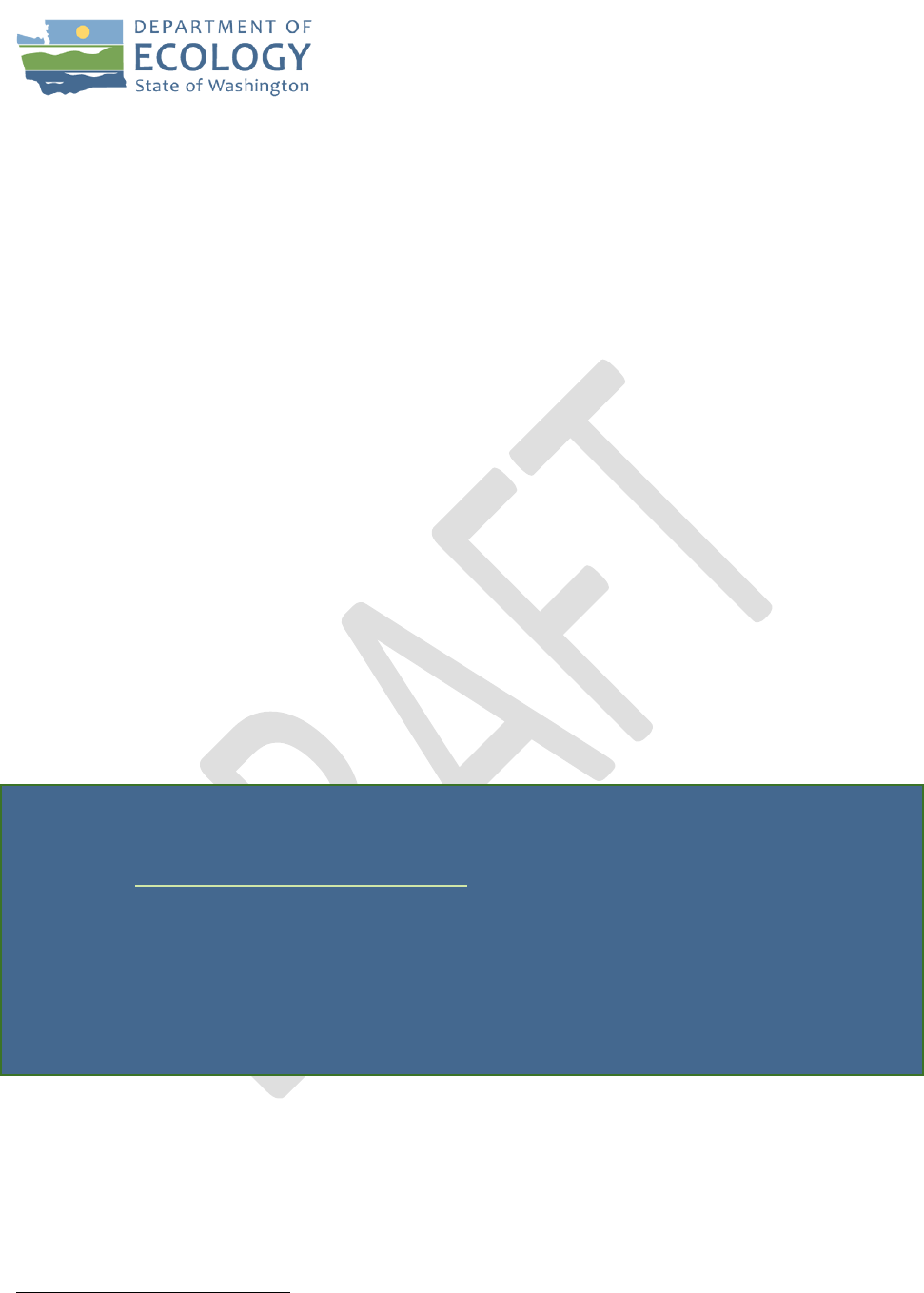
Preliminary Draft Rule Language
Safer Products for Washington
August 2022
(C) Products regulated by the FDA as medical devices.
(b) Compliance schedule. The restriction in (c) of this subsection takes effect on January
1, 2025.
(c) Restriction
(i) No person may manufacture, sell (including but not limited to wholesale,
online, or retail), or distribute a consumer product described in (a) of this
subsection that contains an intentionally added ortho-phthalate used as a
solvent or fixative for fragrance ingredients.
This does not apply to a consumer product described in (a) of this subsection
manufactured before January 1, 2025.
(ii) Ecology presumes the detection of ortho-phthalates, where the ingredients list
does not identify ortho-phthalates but does list fragrances, indicates the
intentional addition of ortho-phthalates used in fragrances.
(iii) Manufacturers may rebut this presumption by submitting a statement to
Ecology that includes the following information.
(A) The name and address of the person submitting the statement.
(B) A statement that the ortho-phthalates were not intentionally added as a
solvent or fixative and evidence supporting that statement. Include
information, data, and sources relevant to demonstrate that the ortho-
phthalates are from a source other than fragrances.
QUESTIONS
Ecology changed the 100 ppm limit to a restriction on “intentionally added” ortho-phthalates in
response to feedback during the June webinars.
12
Some attendees voiced concerns about the
limit being too high.
• Do you think this change addressed concerns about the limit?
• Do you think this change causes other concerns? If yes, what are they?
• Providing your ideas, revised language, references to example regulations or industry
practices, and justification will help Ecology make informed changes.
(2) Vinyl flooring
(a) Applicability. This subsection applies to the following consumer products.
Vinyl flooring
(b) Compliance schedule. The restriction in (c) of this subsection takes effect on January
1, 2025.
12
https://www.ezview.wa.gov/Portals/_1962/Documents/saferproducts/June_2022_Webinar_Presentation.pdf
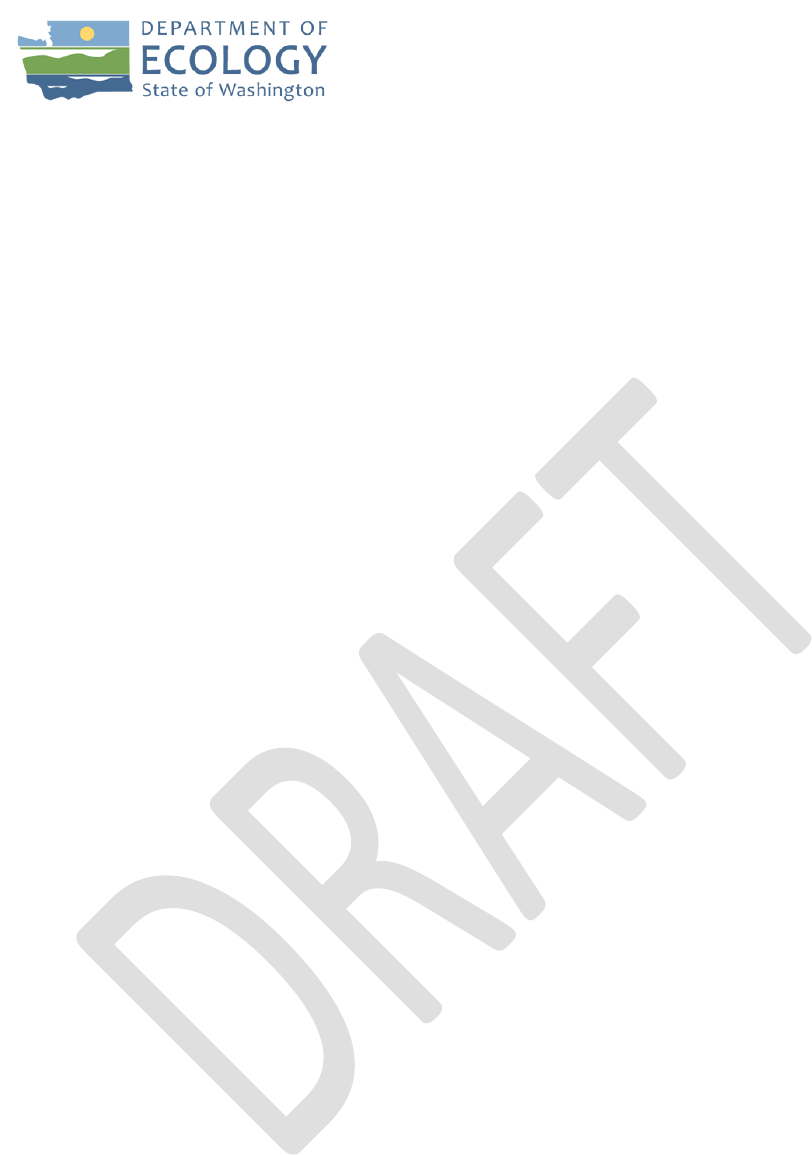
Preliminary Draft Rule Language
Safer Products for Washington
August 2022
(c) Restriction. No person may manufacture, sell (including but not limited to
wholesale, online, or retail), or distribute a consumer product described in (a) of this
subsection that contains more than 1,000 ppm of any ortho-phthalate, individually
or combined.
This does not apply to a consumer product described in (a) of this subsection
manufactured before January 1, 2025.
112 Flame retardants
(1) Plastic external enclosures of electric and electronic products intended for indoor use
(a) Applicability
(i) This subsection applies to the following consumer products.
Plastic external enclosures of electric and electronic products intended for
indoor use that are powered by either of the following:
(A) Standard 120 volt outlets and designed for up to 20 amp circuit
(B) Battery
(ii) This subsection does not apply to:
(A) Plastic external enclosures of electric and electronic products intended
for outdoor use.
(B) Plastic external enclosure parts that weigh less than 0.5 grams.
(C) Inaccessible components, such as printed circuit boards and internal fans.
(D) Wires, cords, cables, switches, light bulbs, and connectors.
(E) Screens. This subsection does apply to the plastic enclosure surrounding
the screen.
(F) Consumer products that receive power only when they are hardwired
into and permanently part of the fixed electrical wiring of a building. This
includes wiring devices, control devices, electrical distribution
equipment, and lighting equipment.
(G) Internal components that are removable and replaceable, but not
accessible once the product is in its fully assembled and functional form.
(H) Products regulated by the FDA as medical devices.
(b) Compliance schedule
(i) The restriction in (c) of this subsection takes effect on January 1, 2025, for
large businesses and small businesses who manufacture, sell (including but not
limited to wholesale, online, or retail), or distribute:
(A) Televisions (TVs) as described in (a) of this subsection.

Preliminary Draft Rule Language
Safer Products for Washington
August 2022
(B) Electronic displays as described in (a) of this subsection.
(ii) The restriction in (c) of this subsection takes effect on January 1, 2026, for
large businesses who manufacture, sell (including but not limited to wholesale,
online, or retail), or distribute a consumer product described in (a) of this
subsection, excluding TVs and electronic displays.
(iii) The restriction in (c) of this subsection takes effect on January 1, 2027, for
small businesses who manufacture, sell (including but not limited to wholesale,
online, or retail), or distribute a consumer product described in (a) of this
subsection, excluding TVs and electronic displays.
(c) Restriction
(i) No person may manufacture, sell (including but not limited to wholesale,
online, or retail), or distribute a consumer product described in (a) of this
subsection that contains more than either of the following:
(A) 1,000 ppm of any intentionally added, individual organohalogen flame
retardant.
(B) 1,500 ppm of any intentionally added, combined organohalogen flame
retardant.
This does not apply to a consumer product described in (a) of this subsection
manufactured before the applicable compliance schedules in (b) of this
subsection.
(ii) Ecology presumes the detection of:
(A) Total bromine concentrations above 1,000 ppm indicate concentrations
of intentionally added organohalogen flame retardants above 1,000 ppm.
(B) Total chlorine concentrations above 1,000 ppm indicate concentrations
of intentionally added organohalogen flame retardants above 1,000 ppm.
(C) Total fluorine concentrations above 1,000 ppm without phosphorus
indicate concentrations of intentionally added organohalogen flame
retardants above 1,000 ppm.
(iii) Manufacturers may rebut this presumption by submitting a statement to
Ecology that includes the following information.
(A) The name and address of the person submitting the statement.
(B) A statement that the consumer product described in (a) of this
subsection does not contain more than 1,000 ppm of any intentionally
added organohalogen flame retardant, and evidence supporting that
statement. Include information, data, and sources relevant to
demonstrate the organohalogens are from a source other than flame
retardants.

Preliminary Draft Rule Language
Safer Products for Washington
August 2022
QUESTIONS
• Ecology clarified the applicability by adding “powered by 120 volt outlets and designed
for up to 20 amp circuit or powered by battery” in response to feedback during the June
webinars.
13
o Is it more accurate or more useful for industry to use “volts” or should this
applicability description use “watts?”
o Do you think this change addressed concerns around the applicability of this product
category?
o Do you think this change causes other concerns? If yes, what are they?
o Providing your ideas, revised language, references to example regulations or industry
practices, and justification will help Ecology make informed changes.
• Ecology added an exclusion for plastic external enclosure parts that weigh less than 0.5
grams to address the concern around “buttons” shared during the June webinars. TCO
Certified
14
does not assess components of external plastic housing that weigh less than
0.5 grams. Therefore, Ecology excluded plastic external enclosure parts that weigh less
than 0.5 grams.
o Do you think this change addressed concerns around “buttons?”
o Do you think this change causes other concerns? If yes, what are they?
o Providing your ideas, revised language, references to example regulations or industry
practices, and justification will help Ecology make informed changes.
• Ecology included three compliance schedules for this product category in response to
feedback during the June webinars.
15
Some attendees voiced concerns about making
the restriction effective as early as possible and some voiced concerns about market
issues and global supply chains. Ecology included the following compliance schedules:
January 1, 2025 for televisions and electronic displays
January 1, 2026 for large businesses, excluding televisions and electronic displays
January 1, 2027 for small businesses, excluding televisions and electronic displays
o Do you think this change addressed concerns around compliance schedules for this
product category?
o Do you think these are the appropriate groups (TVs and displays, large business,
small business) to use?
o How should Ecology define “large business” and “small business?”
13
https://www.ezview.wa.gov/Portals/_1962/Documents/saferproducts/June_2022_Webinar_Presentation.pdf
14
https://tcocertified.com/
15
https://www.ezview.wa.gov/Portals/_1962/Documents/saferproducts/June_2022_Webinar_Presentation.pdf
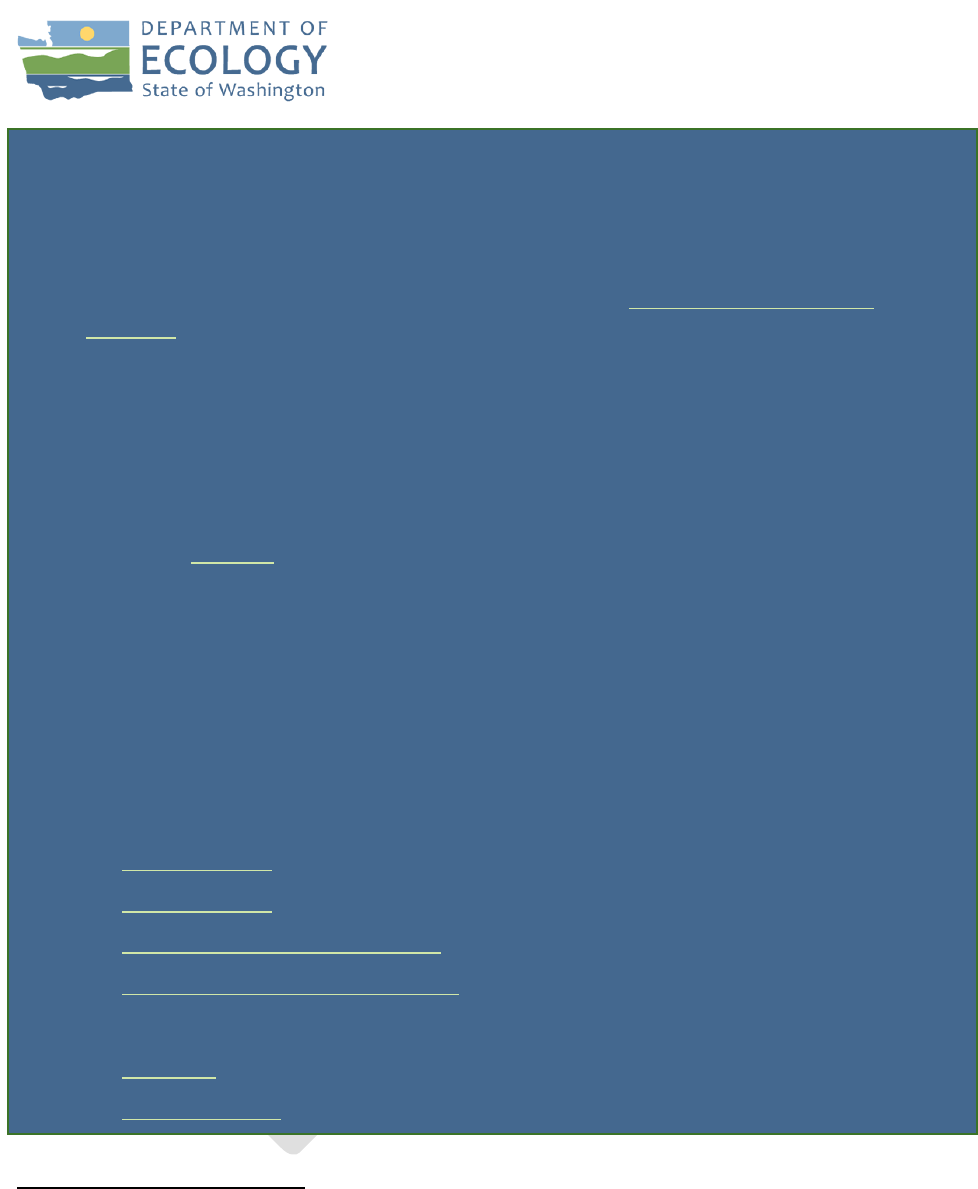
Preliminary Draft Rule Language
Safer Products for Washington
August 2022
o Do you think this change causes other concerns? If yes, what are they?
o Providing your ideas, revised language, references to example regulations or industry
practices, and justification will help Ecology make informed changes.
• Ecology changed “cannot contain organohalogen flame retardants” to “intentionally
added organohalogen flame retardants” in response to feedback during the June
webinars.
16
Attendees voiced concerns about “intentional use.”
o Do you think this change addressed concerns about low-level contamination?
o Do you think this change causes other concerns? If yes, what are they?
o Providing your ideas, revised language, references to example regulations or industry
practices, and justification will help Ecology make informed changes.
• Ecology added a limit of 1,500 ppm for combined organohalogen flame retardants to
match the UL 746H.
17
The revised limit is 1,000 ppm for individual organohalogen flame
retardants and 1,500 ppm for combined organohalogen flame retardants.
o Do you think this change will help manufacturers comply?
o Do you think this change causes other concerns? If yes, what are they?
o Providing your ideas, revised language, references to example regulations or industry
practices, and justification will help Ecology make informed changes.
RESOURCES
• Defining “large business” and “small business”
o RCW 19.85.020
18
o RCW 39.26.010
19
o TSCA and Small Businesses (EPA)
20
o U.S. Small Business Administration
21
• Compliance schedules
o New York
22
o European Union
23
16
https://www.ezview.wa.gov/Portals/_1962/Documents/saferproducts/June_2022_Webinar_Presentation.pdf
17
https://www.shopulstandards.com/ProductDetail.aspx?UniqueKey=28773
18
https://app.leg.wa.gov/RCW/default.aspx?cite=19.85.020
19
https://app.leg.wa.gov/Rcw/default.aspx?cite=39.26.010
20
https://www.epa.gov/tsca-fees/tsca-fees-and-small-businesses
21
https://www.sba.gov/federal-contracting/contracting-guide/size-standards
22
https://legislation.nysenate.gov/pdf/bills/2021/A5418B
23
https://eur-lex.europa.eu/legal-content/EN/TXT/?qid=1576033291584&uri=CELEX:32019R2021
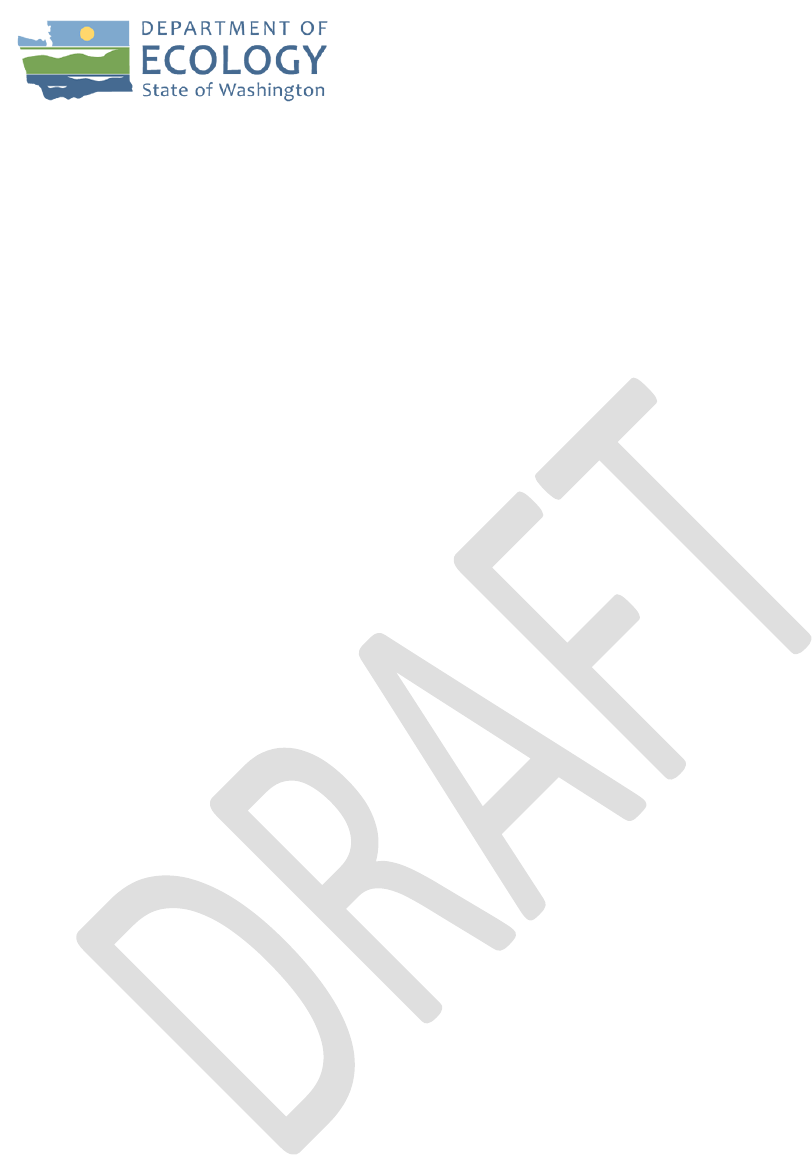
Preliminary Draft Rule Language
Safer Products for Washington
August 2022
(2) Plastic external enclosures of electric and electronic products intended for outdoor use
(a) Applicability
(i) This subsection applies to the following consumer products.
Plastic external enclosures of electric and electronic products intended for
outdoor use that are powered by either of the following:
(A) Standard 120 volt outlets and designed for up to 20 amp circuit
(B) Battery
(ii) This subsection does not apply to:
(A) Plastic external enclosures of electric and electronic products intended
for indoor use.
(B) Plastic external enclosure parts that weigh less than 0.5 grams.
(C) Inaccessible components, such as printed circuit boards and internal fans.
(D) Wires, cords, cables, switches, light bulbs, and connectors.
(E) Screens. This subsection does apply to the plastic enclosure surrounding
the screen.
(F) Consumer products that receive power only when they are hardwired
into and permanently part of the fixed electrical wiring of a building. This
includes wiring devices, control devices, electrical distribution
equipment, and lighting equipment.
(G) Internal components that are removable and replaceable, but not
accessible once the product is in its fully assembled and functional form.
(H) Products regulated by the FDA as medical devices.
(b) Compliance schedule. The reporting requirement in (c) of this subsection takes
effect on January 1, 2024.
(c) Reporting. The manufacturer must provide notice of the use of any organohalogen
flame retardant in a consumer product described in (a) of this subsection. The
manufacturer must provide notice to Ecology in accordance with section 065.
(3) Recreational covered wall padding made from polyurethane foam
(a) Applicability
(i) This subsection applies to the following consumer products.
Recreational covered wall padding made from polyurethane foam
(ii) This subsection does not apply to the consumer products listed in (4)(a)(i) of
this subsection.
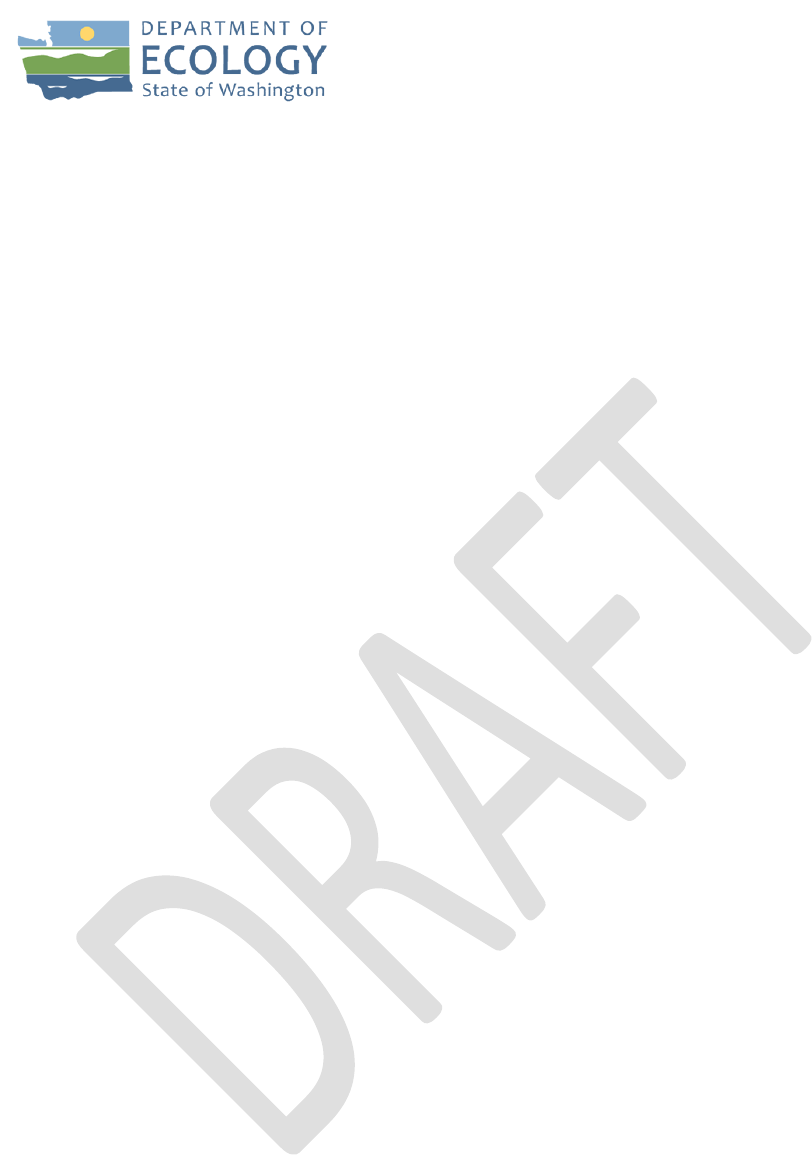
Preliminary Draft Rule Language
Safer Products for Washington
August 2022
(b) Compliance schedule. The reporting requirement in (c) of this subsection takes
effect on January 1, 2024.
(c) Reporting. The manufacturer must provide notice of the use of the following
chemicals in a consumer product described in (a) of this subsection.
(i) Organohalogen flame retardant
(ii) Organophosphate flame retardant
(A) Ethylhexyl diphenyl phosphate (EHDPP, CAS RN: 1241-94-7)
(B) Tributyl phosphate (TNBP, CAS RN: 126-73-8)
(C) Triorthocresyl phosphate (TCP, CAS RN: 78-30-8)
(D) Triphenyl phosphate (TPP, CAS RN: 115-86-6)
The manufacturer must provide notice to Ecology in accordance with section 065.
(4) Other recreational products made from polyurethane foam
(a) Applicability
(i) This subsection applies to the following consumer products.
(A) Recreational covered flooring made from polyurethane foam
(B) Recreational covered mats made from polyurethane foam
(C) Outdoor recreational products made from polyurethane foam
(D) Uncovered recreational products made from polyurethane foam
(ii) This subsection does not apply to:
(A) Wall covering.
(B) Outdoor playground equipment.
(b) Compliance schedule. The restriction in (c) of this subsection takes effect on January
1, 2025.
(c) Restriction
(i) No person may manufacture, sell (including but not limited to wholesale,
online, or retail), or distribute a consumer product described in (a) of this
subsection that contains more than 1,000 ppm of any of the following
chemicals, individually or combined.
(A) Organohalogen flame retardant
(B) Organophosphate flame retardant
• Ethylhexyl diphenyl phosphate (EHDPP, CAS RN: 1241-94-7)
• Tributyl phosphate (TNBP, CAS RN: 126-73-8)
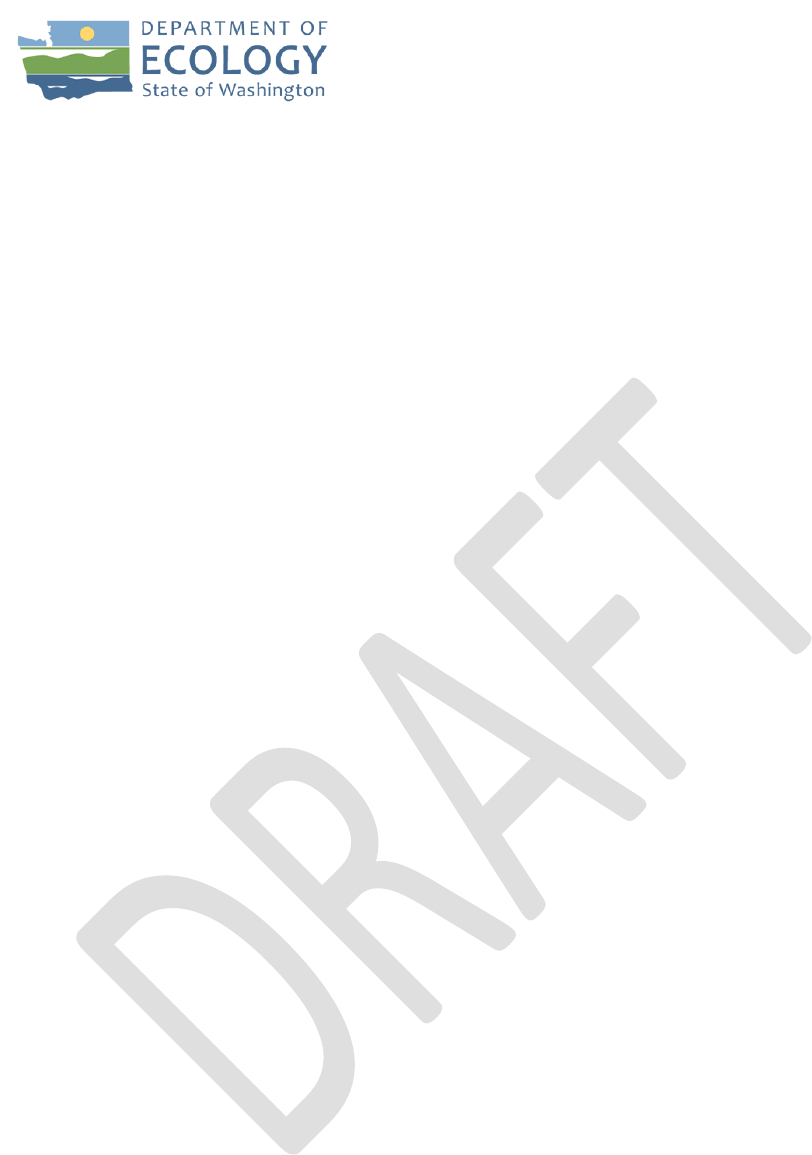
Preliminary Draft Rule Language
Safer Products for Washington
August 2022
• Triorthocresyl phosphate (TCP, CAS RN: 78-30-8)
• Triphenyl phosphate (TPP, CAS RN: 115-86-6)
This does not apply to a consumer product described in (a) of this subsection
manufactured before January 1, 2025.
(ii) Ecology presumes the detection of:
(A) Total bromine concentrations above 1,000 ppm indicate concentrations
of organohalogen flame retardants above 1,000 ppm.
(B) Total chlorine concentrations above 1,000 ppm indicate concentrations
of organohalogen flame retardants above 1,000 ppm.
(C) Total fluorine concentrations above 1,000 ppm indicate concentrations
of organohalogen flame retardants above 1,000 ppm.
(iii) Manufacturers may rebut this presumption by submitting a statement to
Ecology that includes the following information.
(A) The name and address of the person submitting the statement.
(B) A statement that the consumer product described in (a) of this
subsection does not contain more than 1,000 ppm of any of the
chemicals in (c)(i) of this subsection, and evidence supporting that
statement. Include information, data, and sources relevant to
demonstrate that the organohalogens are from a source other than flame
retardants.
113 Alkylphenol ethoxylates
(1) Laundry detergent
(a) Applicability. This subsection applies to the following consumer products.
Laundry detergent
(b) Compliance schedule. The restriction in (c) of this subsection takes effect on January
1, 2025.
(c) Restriction. No person may manufacture, sell (including but not limited to
wholesale, online, or retail), or distribute a consumer product described in (a) of this
subsection that contains more than 1,000 ppm of any alkylphenol ethoxylates,
individually or combined.
This does not apply to a consumer product described in (a) of this subsection
manufactured before January 1, 2025.
114 Bisphenols
(1) Drink can linings
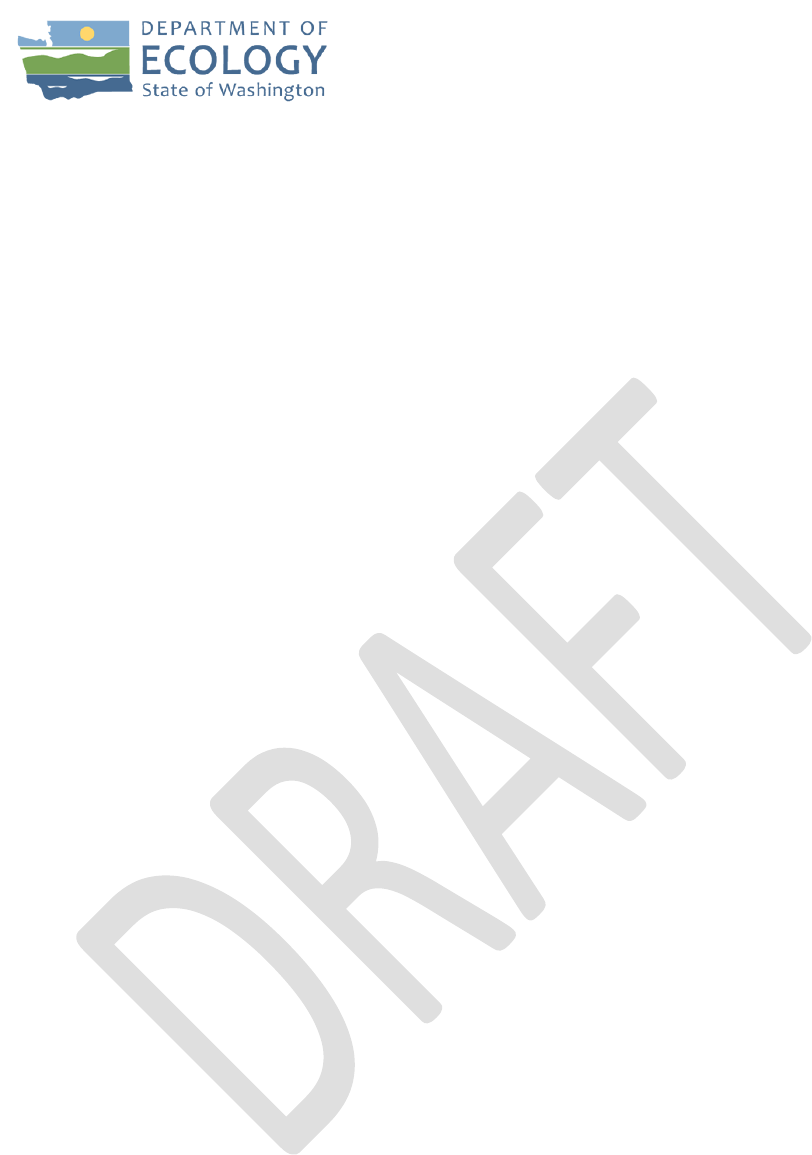
Preliminary Draft Rule Language
Safer Products for Washington
August 2022
(a) Applicability
(i) This subsection applies to the following consumer products.
Drink can linings
(ii) This subsection does not apply to food can linings.
(b) Compliance schedule. The restriction in (c) of this subsection takes effect on January
1, 2025.
(c) Restriction
(i) No person may manufacture, sell (including but not limited to wholesale,
online, or retail), or distribute a consumer product described in (a) of this
subsection that contains a bisphenol-based epoxy can liner, excluding TMBPF-
based epoxy can liners.
This does not apply to a consumer product described in (a) of this subsection
manufactured before January 1, 2025.
(ii) Ecology presumes the detection of a bisphenol, excluding TMBPF, indicates the
use of a bisphenol-based epoxy can liner.
(iii) Manufacturers may rebut this presumption by submitting a statement to
Ecology that includes the following information.
(A) The name and address of the person submitting the statement.
(B) A statement that the consumer product described in (a) of this
subsection does not contain a bisphenol-based epoxy can liner, and
evidence supporting that statement. Include information, data, and
sources relevant to demonstrate that the bisphenol is from a source
other than a bisphenol-based epoxy can liner.
(2) Food can linings
(a) Applicability
(i) This subsection applies to the following consumer products.
Food can linings
(ii) This subsection does not apply to drink can linings.
(b) Compliance schedule. The reporting requirement in (c) of this subsection takes
effect on January 1, 2024.
(c) Reporting. The manufacturer must provide notice of the use of a bisphenol-based
epoxy can liner, excluding TMBPF-based epoxy can liners, in a consumer product
described in (a) of this subsection. The manufacturer must provide notice to Ecology
in accordance with section 065.
(3) Thermal paper

Preliminary Draft Rule Language
Safer Products for Washington
August 2022
(a) Applicability. This subsection applies to the following consumer products.
Thermal paper
(b) Compliance schedule. The restriction in (c) of this subsection takes effect on January
1, 2025.
(c) Restriction. No person may manufacture, sell (including but not limited to
wholesale, online, or retail), or distribute a consumer product described in (a) of this
subsection that contains more than 200 ppm of any individual bisphenol.
This does not apply to a consumer product described in (a) of this subsection
manufactured before January 1, 2025.
